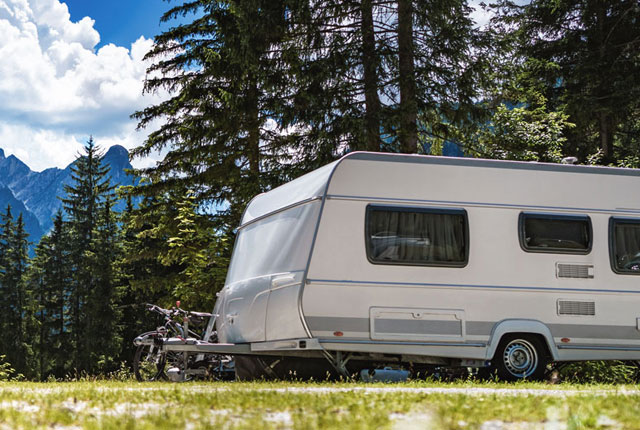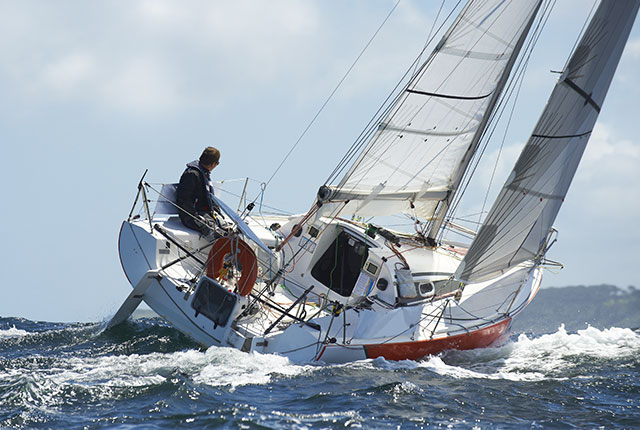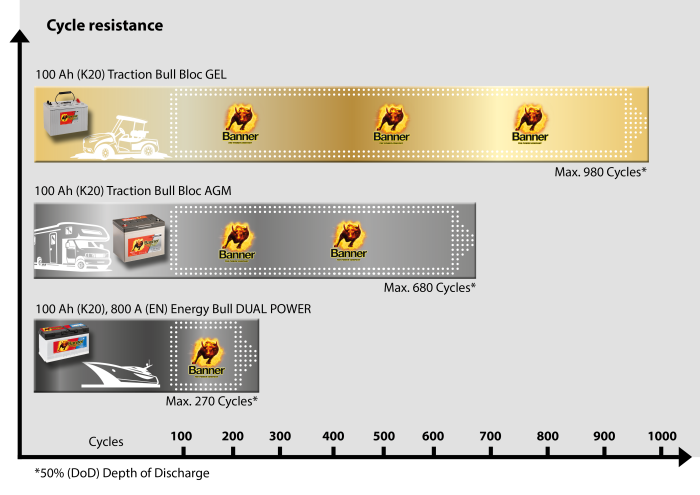HOBBY BATTERIES FOR ENGINE START AND ON-BOARD POWER
ELECTRICITY TO GO!
The on board power for recreation and leisure time
The Banner Energy Bull and Traction Bloc Bull are specialised, professional batteries that stand out from the rest and like professionals, these also do their job: perfectly suited to their field of application and uncompromising in their quality. Among other things, they provide portable energy for sailing and electric boats, yachts, camper vans and motor homes, camping/caravanning and the solar sector.
Banner tip: With its solid cold start values, the Energy Bull DUAL POWER can now of course also be recommended as a starter battery primarily for use in motor boats and motor yachts - almost always spring to autumn operation. For engine starting, especially in motorhomes for winter camping, it is best to continue using a starter battery such as the Running Bull EFB-PROfessional/AGM or the Power Bull. The Energy Bull DUAL POWER then continues to be used as an on-board battery in a dual battery system.
Leading motor home manufacturers such as Knaus Tabbert Reisemobile rely on the best Banner batteries from the Running Bull series as their original equipment.

What type of camper are you?
We have a comprehensive range of camping, caravan and motorhome batteries (on-board power supply and engine start), offering the perfect choice of power and service life to suit any leisure application.
With this in mind, we have developed an easy-to-use battery selection chart that allows the recreational enthusiast to match their specific energy needs to the right battery.
Our simple and clear table will help you to determine the suitable long term discharge battery(ies) for your application that exactly meet(s) your needs. 3 product variants and a total of 3 battery technologies (lead-acid conventional, AGM*, GEL**) are available.
Because as a lover of the outdoors, you’re going to want to enjoy every minute you spend out there. Whether you marvel at ancient sites, tour national parks, enjoy a city break, try out campsites, are a passionate winter camper or simply explore the countries of Europe. You must ensure that you have a reliable on-board power supply that is ideally suited to your type of leisure stay.
*AGM - Absorbent Glass Mat; the acid is absorbed into the glass fleece and thus bound.
= VRLA - Valve Regulated Lead Acid, i.e. a valve-regulated lead-acid battery with AGM technology.
**Gel - Electrolyte is embedded in gel, binding it.
ENERGY BULL
- Battery technology: Conventional lead acid
- Parking bays per trip: Approx. 1-2
- Frequency of use: Occasionally/monthly
- Power connection: 80% on mains - 20% battery
- Solar charging module: Rarely used
- Holiday duration: Weekend, max. 1-2 weeks
- Energy requirements: Standard equipment – low energy requirement
- Approx. number of cycles: Up to 270 (50% discharge depth)
- Charging time: Approx. 10-12 hours (average when using Accucharger 10A/12V)
TRACTION BULL BLOC AGM
- Battery technology: AGM (deep-cycle)
- Parking bays per trip: Approx. 3-6
- Frequency of use: Weekly/daily
- Power connection: 30% on mains - 70% battery
- Solar charging module: Often used, (almost) always in use
- Duration of holiday: Approx. 3-6 weeks
- Energy requirement: Additional equipment – high energy requirement
- Approx. number of cycles: Up to 680 (50% discharge depth)
- Charging time: Approx. 8-10 hours (average when using Accucharger 10A/12V)
TRACTION BULL BLOC GEL
- Battery technology: Gel (deep-cycle)
- Parking bays per trip: Approx. 6 plus
- Frequency of use: Weekly/daily
- Power connection: 10% on mains - 90% battery
- Solar charging module: Always used
- Duration of holiday: Approx. 6 weeks plus
- Energy requirements: Max. additional equipment - maximum energy requirement
- Approx. number of cycles: Up to 980 (50% discharge depth)
- Charging time: Approx. 8-10 hours (average when using Accucharger 10A/12V)
What battery do I need for my motorhome or boat?
You can calculate the capacity requirements of motorhome and boat batteries as on-board power supplies yourself. Here you can see an example of how to determine the power requirement for your use.
Required battery: Energy Bull 96801 K5 = 180 Ah
If the average power-on time is approx. 5 hours, the K5 is used. If it’s approx. 20 hours, the K20 is used and if approx. 100 hours, the K100. With conventional batteries, the safety factor (to prevent deep discharges) should normally be 1.7 (1.3 with recombination batteries, i.e. AGM and gel).
| Device |
P performance in W |
U voltage in V |
Current I - P/U in A |
Activation time in h |
Capacity K = Ixt in Ah |
| Mini-fridge | 100 | 12 | 8,3 | 8 | 66 |
| Mini-TV | 80 | 6,7 | 2 | 13 | |
| Lighting | 40 | 3,3 | 4 | 13 | |
| Kettle | 200 | 16,7 | 0,15 | 3 | |
| Hotplates | 500 | 41,7 | 0,2 | 8 | |
| Total | 103 | ||||
| Required battery capacity (=total multiplied by a safety factor of 1.7) | 175 | ||||

Marine batteries
We have a comprehensive range of boat and yacht batteries (on-board power and engine start), offering the perfect choice of performance and life to suit any leisure application. The same question always pops up. „What battery do I need for my boat?“ With this in mind, we have developed an easy-to-use battery selection chart that enables every boat enthusiast to find the right battery for their boat.
What battery do I need for my boat?
Our simple and clear table will help you to determine the suitable long term discharge battery(ies) for your application that exactly meet(s) your needs. 3 product variants and a total of 3 battery technologies (conventional lead acid, AGM, GEL) are available for boat and yacht batteries.
Because as a recreational captain or skipper, you'll want to enjoy every minute you spend on open waters. No matter whether you spend your weekends exploring inland lakes or rivers, navigating canals, discovering coastal waters or the open sea, taking part in an ocean regatta or sailing around the world. You need to ensure that you have a reliable on-board power supply that best suits your type of use: with a Banner boat battery, you can depend on a reliable power supply.
ENERGY BULL
- Battery technology: Conventional lead acid
- Mooring per sail: Approx. 1-2
- Daily frequency of use: Up to 2 hours
- Day time/Nightly use: Mostly during the day
- Power connection: 80% on mains - 20% battery
- Solar charging module: Rarely used
- Wind and water powered generators: Rarely used
- Daily distance travelled: Up to 20 nautical miles*
- Energy requirements: Standard equipment – low energy requirement
- Approx. number of cycles: Up to 270 (50% discharge depth)
- Charging time: Approx. 10-12 hours (average when using Accucharger 10A/12V)
*1 nautical mile = 1.852 kilometres. Here’s a simple formula for novice seamen to figure out how far a boat has travelled: Double the nautical miles, then subtract 10%.
This is how you get the approximate distance in kilometres.
TRACTION BULL BLOC AGM
- Battery technology: AGM (deep-cycle)
- Mooring per sail: Approx. 3-5
- Daily frequency of use: Approx. 6-8 hours
- Day time/Nightly use: Day and night
- Power connection: 30% on mains - 70% battery
- Solar charging module: Often used, (almost) always in use
- Wind and water powered generators: Often used, (almost) always in use
- Daily distance travelled: Approx. 20-50 nautical miles*
- Energy requirement: Additional equipment - high energy requirement
- Approx. number of cycles: Up to 680 (50% discharge depth)
- Charging time: Approx. 8-10 hours (average when using Accucharger 10A/12V)
*1 nautical mile = 1.852 kilometres. Here’s a simple formula for novice seamen to figure out how far a boat has travelled: Double the nautical miles, then subtract 10%.
This is how you get the approximate distance in kilometres.
Please note: Approx. 50-60 nautical miles of distance per day corresponds to 10-12 hours per day of sailing time at an average speed of 5 knots (and that is fast, for all you non-sailors out there it’s 9.26 km/h to be precise)!
TRACTION BULL BLOC GEL
- Battery technology: Gel (deep-cycle)
- Mooring per sail: Approx. 6 plus
- Daily frequency of use: Approx. 10-12 hours
- Day time/Nightly use: Day and night
- Power connection: 10% on mains - 90% battery
- Solar charging module: Always used
- Wind and water powered generators: Always used
- Daily distance travelled: Approx. 50-80 nautical miles*
- Energy requirements: Max. additional equipment - maximum energy requirement
- Approx. number of cycles: Up to 980 (50% discharge depth)
- Charging time: Approx. 8-10 hours (average when using Accucharger 10A/12V)
*1 nautical mile = 1.852 kilometres. Here’s a relatively simple formula for novice seamen to understand how far a boat has travelled: Double the nautical miles, next subtract 10%.
This is how you get the approximate distance in kilometres.
Please note: Approx. 50-60 nautical miles of distance per day corresponds to 10-12 hours per day of sailing time at an average speed of 5 knots (and that is fast, for all you non-sailors out there it’s 9.26 km/h to be precise)!
Advantages Traction Bull Bloc AGM
Optimal for the operation of powerful, current-intensive consumers due to good high-current characteristics - inverters, coffee machines, hobs, water heaters, ... almost always require high discharge currents. In short, for "maximum power and maximum currents", please consider the storage capacity and current delivery capability for AGM batteries.
Advantages Traction Bull Bloc GEL
Ideal for operating smaller consumers, so do not use with very high discharge currents - battery monitors, marten deterrents, surveillance cameras, USB sockets, .... Always optimal when the power drawn is moderate but is drawn continuously over a longer period of time.
General note
For both battery technologies, it is essential to observe: Never remove the entire nominal capacity from the battery! Banner recommendation: max. 50% depth of discharge (DoD)
Banner tip: In the camping/caravan sector with limited payload, always take the battery weight into account!

Electricity to go on lead-acid technology - wet, AGM and GEL.
Here are the facts briefly noted and visualised, all data always based on 50% depth of discharge (DoD).
We quote cycles that can be applied to a period of time by each individual according to his or her own requirements profile. But it is not serious to simply "confuse" with x years of service life.
In our case, a cycle (partial cycle, not full cycle) means a partial discharge of the battery to 50% residual capacity and subsequent full charge to 100% state of charge.
Conventional wet battery - Energy Bull - up to 270 cycles - for on-board power supply (and as a new DUAL POWER battery now also suitable for engine starting)!
AGM/Fleece battery - Traction Bull Bloc AGM deep cycle - up to 680 cycles - ideal for on-board power supply.
Gel battery - Traction Bull Bloc GEL cycle - up to 980 cycles - optimal for on-board power supply.
Good to know!
Another advantage of lead-acid batteries that is often overlooked:
High-density materials, such as lead, are the ideal and optimal ballast weight for the keel of a sailing boat or yacht! Because a counterweight to the wind pressure in the sail is always necessary! The so-called keel bomb made of lead or an iron alloy, if available, can then be designed to be somewhat lighter.
Nature lovers and outdoor enthusiasts are people with a particularly strong connection to nature and can feel good about the fact that the batteries in use are recycled and reused. Not disposed of and landfilled!
Battery recycling for a clean environment!
No other battery technology is as optimally recyclable, sustainable and environmentally friendly as the lead-acid-based technology used in Energy Bull and Traction Bull.
Lead-acid batteries from Banner are European recycling champions!
In fact, the recycling rate is 100%, which is higher than for aluminium cans, glass or waste paper!
Good to know.
A motor home almost always uses a combination of starter batteries for starting the engine and long-term discharge batteries for supplying all additional electrical/electronic consumers (e.g. lights, fridge, entertainment system, etc.).
Please note: Despite a higher purchase price, a battery with higher cycle stability can pay off over its lifetime, but this always depends on the particular application. In addition, buyers can save on costs for often complex installation and removal including new purchase and transportation.
Banner tip: When operating 230 V appliances (e.g. hairdryer, kettle or coffee maker) via an inverter, add another approx. 15% to the wattage because this is how much energy is lost when the inverter is operated. An inverter (also called a power inverter or rotary converter) is an electrical device that converts direct current into alternating current.
Power tip for checking the electrolyte level in Energy Bull batteries:
Check the electrolyte level regularly and, if necessary, top up with demineralised or distilled water up to the max. acid level mark or 15 mm above the top edge of the plate. Never top up with acid! If there is a high water loss, the regulator voltage should be checked by a specialist.
You might also be interested in the following

